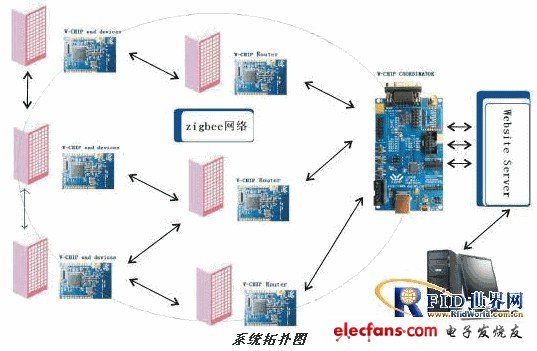ZigBee Technology Overview
The technology specified in the ZigBee protocol is a cheap, low-power, high-reliability short-range wireless networking communication technology. It is a wireless data transmission network platform composed of up to 65000 wireless data transmission modules. In the entire network, each ZigBee network node (FFD) can not only be used as a monitoring object. For example, the sensors connected to the network can directly collect and monitor data, and can also automatically transfer data from other network nodes. In addition, each ZigBee network node can also wirelessly connect with multiple isolated child nodes (RFDs) that do not undertake network information relay tasks within their own signal coverage.
Application areas of wireless transmission systems
The current popular “Internet of Things†(Internet of Things) aims to combine various information sensing devices with the Internet to form a huge network. In this huge network, as a "bridge" between the sensor and the communication network, we can use wired or wireless methods to achieve. In terms of investment, construction, and maintenance of the system, the wireless transmission system obviously has greater advantages.
The application areas of wireless transmission systems mainly include:
Home and building networks: temperature control of air conditioning systems, automatic control of lighting, automatic control of curtains, gas metering control, remote control of household appliances, etc .;
Industrial control: automatic control of various monitors and sensors;
Business: smart tags, etc .;
Public places: smoke detectors, etc .;
Agricultural control: collect various soil information and climate information;
Medical: Emergency call devices and medical sensors for the elderly and people with reduced mobility.
Because these applications are wide and mostly involve personal homes, the market demand for low cost, low power consumption, and high reliability is very strong. Judging from the characteristics of ZigBee products, it is very in line with this market demand.

System topology
Take a deep breath, close your eyes, the world has the freshest oxygen ... Yu Quan's "Deep Breath" is well known to us, but as the environmental problems become more and more serious, the haze sky also increases, PM2.5 PM10 and so on Vocabulary has also been mentioned more and more, and air purifiers have quickly become popular on the market with this "air quality" trend. Along with this, the air-clean brand has sprung up, and various technologies are dazzling. Which ones are indeed effective and which are just tasteless propaganda? How does the Air Purifier bother us to get rid of pollution? And look at the editors for you.
Analysis of air purifier
The critical value of PM2.5 content is 75 μg / m3
The pollutants in the air mainly include soot, total suspended particulates, inhalable particulates (PM2.5) and fine particulates (PM10). The smaller the diameter of the particulates, the deeper the part that can enter the respiratory tract. 10 micron diameter particles It is deposited in the upper respiratory tract, and particles below 2 microns can penetrate 100% into the bronchiole and alveoli.
1k-5k air purifier prices vary greatly
The air purifier products on the market not only have various functions, but also have prices ranging from thousand yuan to tens of thousands. The pricing of imported products is generally higher than that of domestic brands. Except for the core technology of many brands, the promotion of purification effects is similar, and consumers need to choose according to demand.
The air quality standard of 74 key cities is only 4.1%
According to the data of the press conference held by the State Council Information Office on June 4, according to the new "Ambient Air Quality Standards", the six pollutants SO2, NO2, PM10, PM2.5, CO and O3 were evaluated, 74 new standards In the first phase of monitoring and implementation, the proportion of cities that met the ambient air quality standards was only 4.1%, and the other 256 cities implemented the old air quality standards, and the proportion of cities that met the standards was 69.5%.
Air purifier sales increased by 90.5% compared with last year
According to a report recently released by the China Electronics and Information Industry Development Institute, due to the haze weather, air purifiers have become the most concerned home appliance products, with sales of nearly 2.4 million units nationwide last year, a year-on-year increase of 90.5%; retail The amount reached 5.6 billion yuan, a year-on-year increase of 105.9%.
HEPA filter needs to be replaced in March
The filter of the air purifier is the same as the filter of the water purifier, and it is not effective for a long time. After long-term use, the accumulation of dust on the surface of the filter will also cause the filter to gradually fail. Therefore, when the haze is more serious, the non-washable HEPA filter needs to be replaced every three months.
Merchants claim that the purification rate is more than 99% for the concept of stealing
99% or even 99.99% seems to have become a slogan for many air purifiers on the market. Many brands of products promote their high removal rate of PM2.5 and formaldehyde. In fact, this kind of publicity is more of a kind. The slogan of stealing the concept, the removal rate of 99% is the effect of the material itself on PM2.5 and formaldehyde, not the effect of actually running in space.
Air Cleaner,Household Air Cleaner,Office Air Cleaner,Air Cleaner For Children
Ningbo Zhe Kai Electric Appliance Co.,Ltd , https://www.cnairpurifiers.com
![<?echo $_SERVER['SERVER_NAME'];?>](/template/twentyseventeen/skin/images/header.jpg)